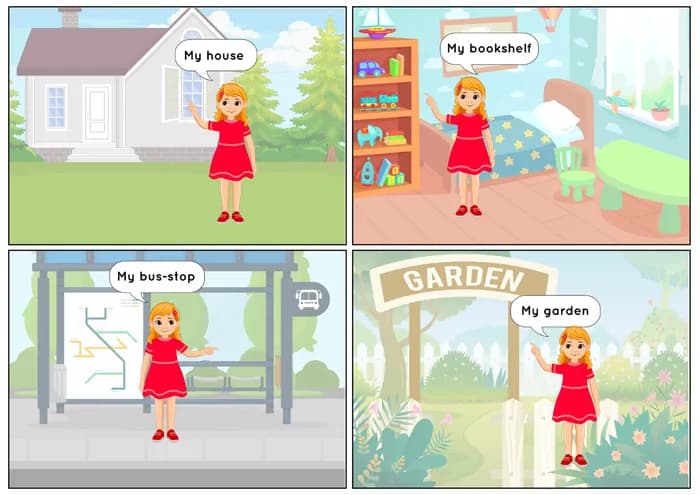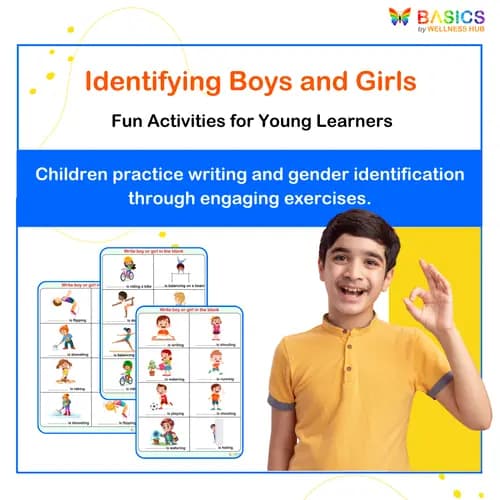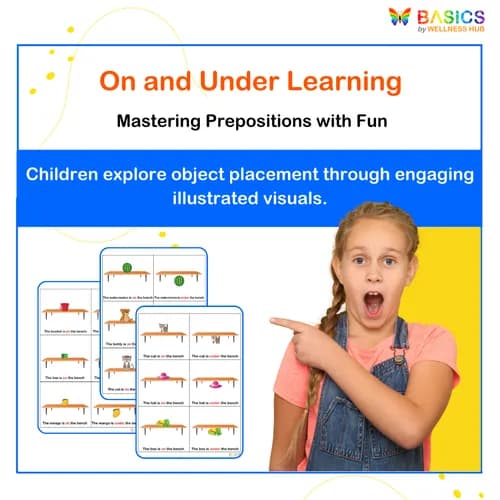





Caucasian Girl: Learn 'My' with Everyday Objects – Printable PDF
₹80
₹160
50% off
0 (0 ratings)
Grade Levels
Pre-K - Grade 1 (Ages 3-6)
Content Overview
Format: Printable PDF, Total Pages: 8, Features: 32 illustrated pictures teaching possession with 'My' phrases.
Categories
Pages from the Resource
Teach children possession and belonging with this engaging printable PDF featuring a Caucasian girl and her favorite items. Each page includes 4 illustrated pictures with phrases like 'My bag' and 'My doll,' helping kids build vocabulary and early grammar skills in a fun, visual way. Perfect for ages 3-6.

Page 1

Page 2
What Users Say
0
0 ratings
5
0+
4
0+
3
0+
2
0+
1
0+
5 Stars
Product is Good to use.
1 year ago
Varsha Parent
Similar Products

CAUCASIAN BOY: Learn “My” with Everyday Objects – Printable PDF
₹ 80.00
₹ 160.00
50% off
4.9 (52 ratings)

ON & UNDER: Everyday Objects – Printable PDF for Kids
₹ 80.00
₹ 160.00
50% off
5.0 (56 ratings)

Identifying Boys and Girls: Printable PDF for Observation and Writing
₹ 80.00
₹ 160.00
50% off
4.9 (52 ratings)

Hard and Soft Objects Worksheets – Printable PDF for Kids
₹ 80.00
₹ 160.00
50% off
4.9 (52 ratings)

ON & UNDER: Basic Object Position – Printable PDF for Kids
₹ 80.00
₹ 160.00
50% off
4.8 (48 ratings)
About the Product
Introduction
Introducing young children to the concept of possession is a crucial step in their language development. The "My" with Everyday Objects printable PDF resource is designed to help children aged 3-6 learn to express ownership and belonging through engaging visuals and simple phrases. Featuring a charming Caucasian girl character, this resource presents 32 illustrated pictures across 8 pages, each depicting the girl with her belongings, family members, or favorite items.
Each image is accompanied by a clear phrase that begins with "My," such as "My bag," "My doll," and "My pet." This format not only reinforces vocabulary but also introduces early grammar skills in a fun and relatable way. Ideal for use at home, in preschool settings, or during therapy sessions, this resource encourages self-expression and helps children build confidence in their language abilities.
Product Details
- Product Name: "My" with Everyday Objects: Printable PDF
- Format: Printable PDF
- Total Pages: 8
- Illustrated Pictures: 32 (4 pictures per page)
- Content: Each page features a Caucasian girl with one belonging, labeled with a "My ..." phrase.
- Example Phrases: My bag, My doll, My ribbons, My toys, My dress, My school, My mother, My pet.
- Designed For: Early childhood education, language development, speech therapy, and vocabulary building.
Educational Benefits
1. Enhances Vocabulary Development
- Introduces children to a variety of nouns related to personal belongings and family members.
- Encourages the use of descriptive language through simple, relatable phrases.
2. Promotes Understanding of Possession
- Helps children grasp the concept of ownership by using "My" in context.
- Reinforces the idea of belonging, which is important for social-emotional development.
3. Supports Early Grammar Skills
- Introduces basic sentence structure by focusing on the possessive pronoun "My."
- Encourages children to form complete thoughts, laying the groundwork for more complex sentences.
4. Boosts Self-Expression and Confidence
- Empowers children to talk about their personal items and family, fostering a sense of identity.
- Encourages sharing and conversation with peers and adults about their belongings.
5. Engaging Visual Learning
- Utilizes colorful illustrations to capture children's attention and aid in memory retention.
- Supports visual learners by pairing images with text, making learning more interactive and enjoyable.
Instructions for Use
Step 1: Print the PDF
- Download and print the "My" with Everyday Objects PDF on standard A4 or Letter-sized paper.
- Consider laminating the pages for durability and repeated use in various settings.
Step 2: Read Together
- Sit with the child and go through each page, pointing to the illustrations as you read the phrases aloud.
- Encourage the child to repeat the phrases after you to reinforce learning.
Step 3: Encourage Interaction
- Ask the child to identify their own belongings using the "My" structure (e.g., "My toy," "My book").
- Use prompts like "What is your favorite toy?" to stimulate conversation.
Step 4: Engage in Role-Playing
- Create scenarios where the child can practice using "My" in context, such as during playtime or while organizing their room.
- Encourage them to describe their items using the phrases from the resource.
Step 5: Use for Vocabulary Building
- Incorporate the illustrated pictures into vocabulary games, such as matching items with their names or creating sentences.
- Use flashcards or memory games to reinforce the vocabulary learned.
Step 6: Reinforce Learning Over Time
- Revisit the PDF regularly to reinforce the concepts and phrases.
- Encourage the child to use "My" in everyday conversations to build fluency and confidence in their language skills.
Activities Using the Resource
1. Picture Labeling
Objective: Enhance vocabulary by identifying personal belongings.
How to Play:
- Print the pages and cut out the illustrated pictures.
- Ask the child to label each picture with the phrase "My..." (e.g., "My bag").
- Encourage them to create their own sentences using the phrase.
Skill Development:
- Vocabulary expansion
- Sentence formulation
- Confidence in self-expression
2. Ownership Role-Play
Objective: Practice using "My" in real-life scenarios.
How to Play:
- Set up a play area with the child's belongings.
- Ask the child to introduce each item using "My" (e.g., "My toy car").
- Role-play different scenarios where they can show ownership (e.g., sharing with a friend).
Skill Development:
- Social skills
- Expressive language
- Understanding of possession
3. My Belongings Collage
Objective: Create a visual representation of ownership.
How to Play:
- Provide magazines or printed images of various items.
- Ask the child to cut out pictures of their belongings and glue them onto a poster.
- Label each item with "My..." phrases.
Skill Development:
- Creative expression
- Fine motor skills
- Vocabulary reinforcement
4. Memory Match Game
Objective: Improve memory and recognition of vocabulary.
How to Play:
- Create pairs of cards using the illustrated pictures and their corresponding "My..." phrases.
- Shuffle and lay them face down.
- Take turns flipping two cards to find matching pairs.
Skill Development:
- Memory recall
- Visual discrimination
- Turn-taking skills
5. Storytime with "My"
Objective: Encourage narrative skills and imaginative play.
How to Play:
- Read through the PDF together, then ask the child to create a story using the "My" phrases.
- Prompt them with questions like, "What does she do with her doll?" or "Where does she keep her bag?"
Skill Development:
- Storytelling abilities
- Imagination and creativity
- Sentence structure understanding
6. Daily "My" Conversations
Objective: Reinforce the use of "My" in everyday language.
How to Play:
- During daily routines, encourage the child to describe their belongings using "My" (e.g., "My breakfast," "My shoes").
- Make it a fun challenge to find new items to describe throughout the day.
Skill Development:
- Everyday language use
- Confidence in communication
- Reinforcement of ownership concepts
Frequently Asked Questions
Q1: What age group is this resource designed for?
A1: This resource is specifically designed for children aged 3 to 6 years. It focuses on early language development, helping young learners understand the concept of possession through relatable visuals and simple phrases. The engaging illustrations and straightforward language make it suitable for preschool and early elementary settings.
Q2: Can I use this resource in a therapy setting?
A2: Yes, this resource is excellent for speech and language therapy. It supports vocabulary building, sentence structure, and self-expression, making it a valuable tool for therapists working with young children. The visual aids help reinforce learning and can be used in various interactive activities to enhance engagement.
Q3: How can I differentiate this resource for children with special needs?
A3: This resource can be easily differentiated by adjusting the pace of the activities or by using fewer images per page for children who may need more time to process information. Additionally, you can pair the visuals with tactile objects that represent the items in the illustrations, allowing for a multi-sensory approach to learning.
Q4: Are there any suggestions for integrating this resource into my curriculum?
A4: This resource can be integrated into various subjects, such as language arts and social studies, by using it to teach vocabulary related to family and belongings. You can also create group activities where children share their own "My" sentences, fostering a sense of community and encouraging peer interaction.
Q5: What is your refund policy for digital resources?
A5: Due to the nature of digital products, we do not offer refunds once the PDF has been downloaded. However, if you encounter any issues with the download or the file itself, please contact our support team, and we will do our best to assist you.
Q6: How can I contact support if I have questions or issues?
A6: You can reach our support team through the contact form on our website or by emailing us directly. We strive to respond to all inquiries within 24-48 hours. Our team is here to help with any questions regarding your purchase, resource usage, or technical issues.
Q7: Do you offer bulk or school licensing for your resources?
A7: Yes, we offer bulk licensing options for schools and organizations that wish to purchase multiple copies of our resources. This is a great way to ensure that all educators and therapists have access to the materials they need for effective teaching and therapy.
Q8: How will I receive my digital resource after purchase?
A8: After completing your purchase, you will receive an email with a download link to access your digital PDF resource. You can download it directly to your device for immediate use. If you do not receive the email, please check your spam folder or contact our support team for assistance.
Q9: What types of resources does Wellness Hub provide?
A9: Wellness Hub offers a wide range of resources, including flashcards, worksheets, and visual schedules designed to support children and families in various developmental areas. These resources are created to complement therapy sessions and help parents continue their child's progress at home.
Q10: How does Wellness Hub ensure the quality of its therapy services?
A10: Wellness Hub employs qualified therapists with expertise in various fields, including speech and language therapy, occupational therapy, and behavioral therapy. Our approach emphasizes caregiver involvement and privacy, ensuring that therapy is effective, affordable, and accessible to families across India and beyond.
Usage Rights and Restrictions
Allowed Usage:
- Personal use by parents, teachers, and therapists.
- Printable for classroom, home, or therapy settings.
- Can be used in group or one-on-one learning sessions.
Not Allowed:
- Reselling, redistributing, or modifying the resource for commercial use.
- Sharing publicly (e.g., on blogs, social media, or websites) without permission.
- Uploading the file to public sharing platforms.
If you need a bulk license for schools or therapy centers, please contact us.
Conclusion
The "My" with Everyday Objects printable PDF is an essential resource for young children aged 3-6, designed to foster their understanding of possession and enhance their language skills. Through engaging illustrations and relatable phrases, this resource not only aids in vocabulary development but also promotes self-expression and confidence in communication. Children will enjoy identifying their belongings and practicing the use of "My" in everyday contexts, making learning both fun and meaningful.
Ideal for use at home, in preschool settings, or during therapy sessions, this resource provides a structured approach to language development. By integrating these activities into daily routines, caregivers and educators can support children in building a strong foundation for future communication skills. Download your copy today and empower your child to express their individuality and ownership with confidence!



